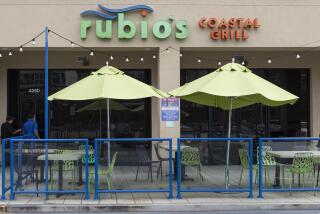Commodities Go High-Tech in London : Today’s the Day That Markets Move to Modern Exchange
- Share via
LONDON — London’s quaint commodities trading markets are leaping into the high-tech age.
The coffee, cocoa and sugar futures markets of the London Commodity Exchange shift business today from genteel and secluded premises in London’s “City” financial district--where they began in the coffee shops of 300 years ago--to a gleaming new edifice called Commodity Quay.
It is all part of a bid by London to keep its place as a mercantile hub and meet U.S. competition in the trading of just about anything that can be traded, using the latest electronic wizardry to clinch the deals.
Futures (contracts that fix the price of a commodity for delivery at a future date) have long been used by producers and users to lessen the risk of losing money in their business.
In the current decade, futures contracts were started in London for petroleum. And the heating oil, heavy fuel oil, leaded gasoline and Brent crude oil index futures markets of London’s International Petroleum Exchange also move today to Commodity Quay.
Single Exchange
The markets will congregate at this one exchange, built for $9.25 million in the Docklands--an area of derelict wharves being redeveloped by Prime Minister Margaret Thatcher’s Conservative government.
Hitherto, the various markets were in separate locations. But LCE Chairman Saxon Tate says that, to beat the foreign competition and attract customers, “we need the synergy of having all the business in one place. Trade adds trade, and costs to each market will diminish with all under one roof.
“We must change from a terminal market based in the 19th Century to a modern futures and options exchange in the 20th Century,” he said.
Traders will work on a 12,500-square-foot trading floor, capacity 500, with price screens, quotation boards, several octagonal trading pits and elbow-high trading rings of vivid red, blue, green and yellow.
Bucking a sleepy and uncompetitive “auntie image,” Tate said, “will take time, but it can be done.”
The London markets operate on an intimate broker-dealer system, with traders sitting around a ring.
But in the inflationary 1970s, financial and commodity markets in other cities thrived, and London lost customers to more exciting and lucrative exchanges in New York and Chicago, where business is done by “open outcry”--shouting prices and quantities and making elaborate hand signals to accompany each bid and offer.
Even now, with the shift to Commodity Quay, the cocoa market, one of the oldest and most conservative, has had a glass barrier erected between its area and the other markets to keep noise out, cocoa traders said.
Only the energy market voted to have American-style trading pits.
Slow Expansion
“If anybody expects a big bang in the London commodity markets he’s going to be disappointed. It will be a slow, steady expansion,” said Marc Bailey, a newly admitted “local.”
Bringing in “locals” like Bailey is the most controversial of the changes now being made. Such players are individuals, trading to make money for themselves rather than established commodity houses, and have long been present in U.S. exchanges, bringing extra liquidity to the market.
In June, 20 of them will be introduced to a London market hitherto oriented to the user of commodities, rather than to speculative trade. Fifty locals, vetted for financial stability and expertise, will eventually be members.
Some established firms fear they will lose business. Some say business volume could decline because the new locals will not have the financial backing to take big trading positions.
Newly admitted Bailey disagreed. “We hope we can show the firms we’re here not to trade off their backs but to trade with them, to create business and not to take it away,” he said.
Tate projected London commodity futures business would double in three to five years in the new exchange. “To be viable we have to be twice as big.”
More to Read
Inside the business of entertainment
The Wide Shot brings you news, analysis and insights on everything from streaming wars to production — and what it all means for the future.
You may occasionally receive promotional content from the Los Angeles Times.










